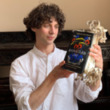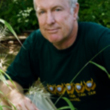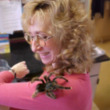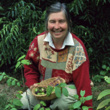The Heartbeat of Trees: Embracing Our Ancient Bond with Forests and Nature
(Libby/OverDrive eAudiobook)
Available Platforms
Description
FROM THE AUTHOR OF THE NEW YORK TIMES BESTSELLER, THE HIDDEN LIFE OF TREES
A powerful return to the forest, where trees have heartbeats and roots are like brains that extend underground. Where the color green calms us, and the forest sharpens our senses.
In The Heartbeat of Trees, renowned forester Peter Wohlleben draws on new scientific discoveries to show how humans are deeply connected to the natural world.In an era of cell phone addiction, climate change, and urban life, many of us fear we’ve lost our connection to nature—but Peter Wohlleben is convinced that age-old ties linking humans to the forest remain alive and intact.
Drawing on science and cutting-edge research, The Heartbeat of Trees reveals the profound interactions humans can have with nature, exploring:
- the language of the forest
- the consciousness of plants
- and the eroding boundary between flora and fauna.
A perfect book to take with you into the woods, The Heartbeat of Trees shares how to see, feel, smell, hear, and even taste the forest.
Peter Wohlleben, renowned for his ability to write about trees in an engaging and moving way, reveals a wondrous cosmos where humans are a part of nature, and where conservation and environmental activism is not just about saving trees—it’s about saving ourselves, too.
Praise for The Heartbeat of Trees
“As human beings, we’re desperate to feel that we’re not alone in the universe. And yet we are surrounded by an ongoing conversation that we can sense if, as Peter Wohlleben so movingly prescribes, we listen to the heartbeat of all life.” —Richard Louv, author of Our Wild Calling and Last Child in the Woods
“Astonishment after astonishment—that is the great gift of The Heartbeat of Trees. It is both a celebration of the wonders of trees, and a howl of outrage at how recklessly we profane them.” —Kathleen Dean Moore, author of Earth’s Wild Music
“As Peter Wohlleben reminds us in The Heartbeat of Trees, trees are the vocabulary of nature as forests are the brainbank of a living planet. This was the codex of the ancient world, and it must be the fine focus of our future.” —Dr. Diana Beresford-Kroeger, author of To Speak for the Trees and The Global Forest
“Peter Wohlleben knows the battle that lies before us: forging a closer relationship with nature before we destroy it. In The Heartbeat of Trees he takes us deep into the global forest to show us how.”—Jim Robbins, author of The Man Who Planted Trees
More Details
Similar Titles From NoveList
Similar Authors From NoveList
Published Reviews
Booklist Review
Forester turned ecologist and educator Wohlleben follows his best-selling Mysteries of Nature series--The Hidden Life of Trees, 2016; The Inner Life of Animals, 2017; The Secret Wisdom of Nature, 2019--with a return to the wonders of trees. Part of what one might call the "awaken awe" school of nature writing, Wohlleben amiably explains how our "ancient bond" with trees is evident in the evolution of our senses and in the many ways a walk in the forest is so beneficial for our health. He presents the latest scientific findings illuminating how trees communicate, respond to their surroundings, and feel pain, and how their pumping of water at regular intervals creates "heartbeats." As Wohlleben visits primeval forests in Europe and North America, he sharply contrasts them with tree plantations, decries clear-cutting, cites the many threats against old-growth forests, and elucidates precisely why "true forests" are "our most powerful allies in the fight against climate change." By celebrating the complex interconnectivity of forests and how they sustain so many life forms, including our own, Wohlleben seeks to summon veneration, empathy, and advocacy for trees.
Publisher's Weekly Review
Forester Wohlleben (The Hidden Life of Trees) takes an eclectic look at humanity's relationships with trees in this heartfelt survey. To prove that "the ancient tie that binds humans and nature exists to this day and is as strong as ever," Wohlleben looks at tree worship (including the "marriage of trees" ritual in Italy), common expressions such as "shaking like a leaf," and the various ways humans use products derived from plants for medication (willow tree bark helps with headaches, for example). He also notes traits shared between plants and humans: a South American vine can see, he argues, as it creates leaves exactly like those of its host tree, and he offers evidence that spruce trees feel pain when attacked by bark beetles. Paramount to Wohlleben is the role forests play in the health of nature and civilization--he mourns the destruction of diverse old-growth forests, and decries modern forestry's single species "plantations," where endless cycles of planting, thinning, and clear-cutting destroy the very meaning of forest. Along the way, moving accounts of fellow activists' efforts to save treasured woodlands bolster his plea that humans should let forests return to their natural state. Nature-minded readers will enjoy this episodic deep dive. (June)
Library Journal Review
The best selling author of The Hidden Life of Trees revisits a favorite subject. While Hidden Life focused on arboreal wonders, Wohlleben's new book (originally published in Germany in 2019) is as much about human life as it is about trees. Humanity's bond with nature has not been severed, Wohlleben claims, just forgotten. In his trademark conversational style, he explains why we feel good around trees and how, by opening our senses, we can benefit from them. The book's rambling form, appropriately, is like a walk in the woods: 31 short chapters or essays cover diverse topics, including our historical connections to trees, trees' electrical fields, forest bathing, invasive species, climate change, and more. Along the way, Wohlleben takes some jabs at conservative science, industrial forestry, and greenwashing in its many guises. He urges hope, not despair, about our environmental malaise, and closes with a message: laws and regulations won't save our forest friends, but we can, if only we can reconnect with nature through empathy. VERDICT Finding "fascinating phenomena all over the place," Wohlleben sticks with the formula that made his earlier work so popular. This latest book will appeal to fans of popular science and anyone curious about natural history.--Robert Eagan, Windsor P.L., Ont.
Kirkus Book Review
The bestselling author of The Hidden Life of Trees returns with another heartfelt collection of essays celebrating the natural world. In his latest, German forester and nature writer Wohlleben writes that while "there has been renewed interest in ways to immerse ourselves in nature," many of us have ignored it. We have allowed our lives to become filled with artificial lights, sounds, and scents, all of which have adverse effects on our well-being. Drawing on scientific evidence and his many years of experience, the author extolls the wonders of the forest, including the calming effects of the colors and aromas of nature as well as the growing popularity of "forest bathing" as therapy. Wohlleben also points out the many direct health benefits of plants and trees--e.g., using willow bark to cure headaches, maple leaves to treat insect bites, and spruce resin to make chewing gum, not to mention the nutritional value that can be found in the leaves of a wide variety of plants across the world. The author discredits many of the myths that prevent people from exploring the outdoors, including fear of assault, encounters with dangerous animals, and exposure to allergens. Throughout, he emphasizes the importance of conservation. Other topics include the introduction of invasive species to forests through global trade and tourism, the impact of fertilizers, and the link between the destruction of indigenous forests and climate change. In an attempt to raise awareness and protect ancient forests and their communities, Wohlleben describes the measures he has implemented in Germany, including the first burial grounds in which a person can choose the tree under which they will be laid to rest, programs offering leases for plots of forest, seminars for hunters to end fox hunting, and educational tours for children. A persuasive invitation to get outside and bathe in nature, perfect for tree huggers and fans of the author's other books. Copyright (c) Kirkus Reviews, used with permission.
Booklist Reviews
Forester turned ecologist and educator Wohlleben follows his best-selling Mysteries of Nature series—The Hidden Life of Trees, 2016; The Inner Life of Animals, 2017; The Secret Wisdom of Nature, 2019—with a return to the wonders of trees. Part of what one might call the "awaken awe" school of nature writing, Wohlleben amiably explains how our "ancient bond" with trees is evident in the evolution of our senses and in the many ways a walk in the forest is so beneficial for our health. He presents the latest scientific findings illuminating how trees communicate, respond to their surroundings, and feel pain, and how their pumping of water at regular intervals creates "heartbeats." As Wohlleben visits primeval forests in Europe and North America, he sharply contrasts them with tree plantations, decries clear-cutting, cites the many threats against old-growth forests, and elucidates precisely why true forests are "our most powerful allies in the fight against climate change." By celebrating the complex interconnectivity of forests and how they sustain so many life forms, including our own, Wohlleben seeks to summon veneration, empathy, and advocacy for trees. Copyright 2021 Booklist Reviews.
Library Journal Reviews
The best selling author of The Hidden Life of Trees revisits a favorite subject. While Hidden Life focused on arboreal wonders, Wohlleben's new book (originally published in Germany in 2019) is as much about human life as it is about trees. Humanity's bond with nature has not been severed, Wohlleben claims, just forgotten. In his trademark conversational style, he explains why we feel good around trees and how, by opening our senses, we can benefit from them. The book's rambling form, appropriately, is like a walk in the woods: 31 short chapters or essays cover diverse topics, including our historical connections to trees, trees' electrical fields, forest bathing, invasive species, climate change, and more. Along the way, Wohlleben takes some jabs at conservative science, industrial forestry, and greenwashing in its many guises. He urges hope, not despair, about our environmental malaise, and closes with a message: laws and regulations won't save our forest friends, but we can, if only we can reconnect with nature through empathy. VERDICT Finding "fascinating phenomena all over the place," Wohlleben sticks with the formula that made his earlier work so popular. This latest book will appeal to fans of popular science and anyone curious about natural history.—Robert Eagan, Windsor P.L., Ont.
Copyright 2021 Library Journal.Publishers Weekly Reviews
Forester Wohlleben (The Hidden Life of Trees) takes an eclectic look at humanity's relationships with trees in this heartfelt survey. To prove that "the ancient tie that binds humans and nature exists to this day and is as strong as ever," Wohlleben looks at tree worship (including the "marriage of trees" ritual in Italy), common expressions such as "shaking like a leaf," and the various ways humans use products derived from plants for medication (willow tree bark helps with headaches, for example). He also notes traits shared between plants and humans: a South American vine can see, he argues, as it creates leaves exactly like those of its host tree, and he offers evidence that spruce trees feel pain when attacked by bark beetles. Paramount to Wohlleben is the role forests play in the health of nature and civilization—he mourns the destruction of diverse old-growth forests, and decries modern forestry's single species "plantations," where endless cycles of planting, thinning, and clear-cutting destroy the very meaning of forest. Along the way, moving accounts of fellow activists' efforts to save treasured woodlands bolster his plea that humans should let forests return to their natural state. Nature-minded readers will enjoy this episodic deep dive. (June)
Copyright 2021 Publishers Weekly.Reviews from GoodReads
Citations
Wohlleben, P., & Grady, M. (2021). The Heartbeat of Trees: Embracing Our Ancient Bond with Forests and Nature (Unabridged). Greystone Books.
Chicago / Turabian - Author Date Citation, 17th Edition (style guide)Wohlleben, Peter and Mike Grady. 2021. The Heartbeat of Trees: Embracing Our Ancient Bond With Forests and Nature. Greystone Books.
Chicago / Turabian - Humanities (Notes and Bibliography) Citation, 17th Edition (style guide)Wohlleben, Peter and Mike Grady. The Heartbeat of Trees: Embracing Our Ancient Bond With Forests and Nature Greystone Books, 2021.
Harvard Citation (style guide)Wohlleben, P. and Grady, M. (2021). The heartbeat of trees: embracing our ancient bond with forests and nature. Unabridged Greystone Books.
MLA Citation, 9th Edition (style guide)Wohlleben, Peter, and Mike Grady. The Heartbeat of Trees: Embracing Our Ancient Bond With Forests and Nature Unabridged, Greystone Books, 2021.
Copy Details
| Collection | Owned | Available | Number of Holds |
|---|---|---|---|
| Libby | 3 | 1 | 1 |




































